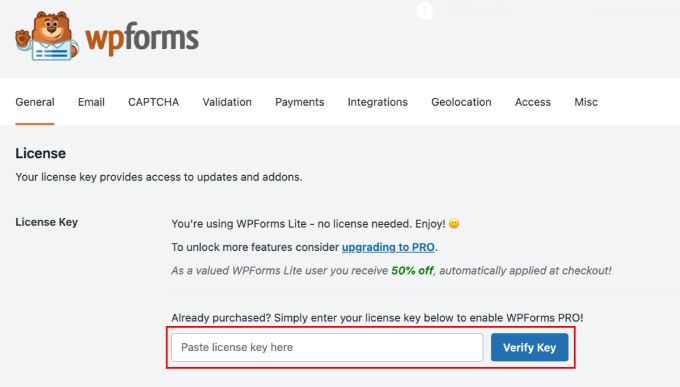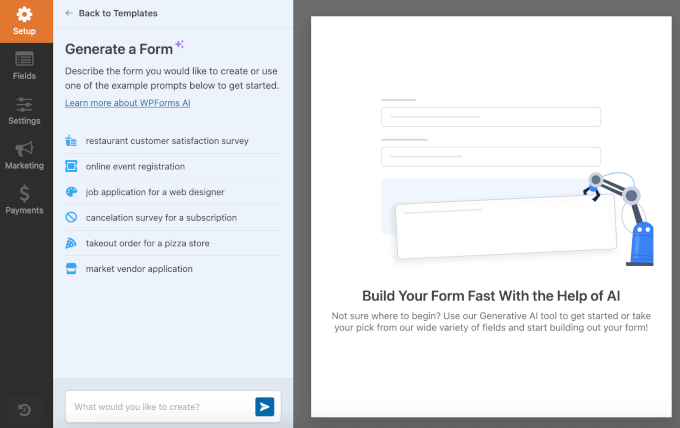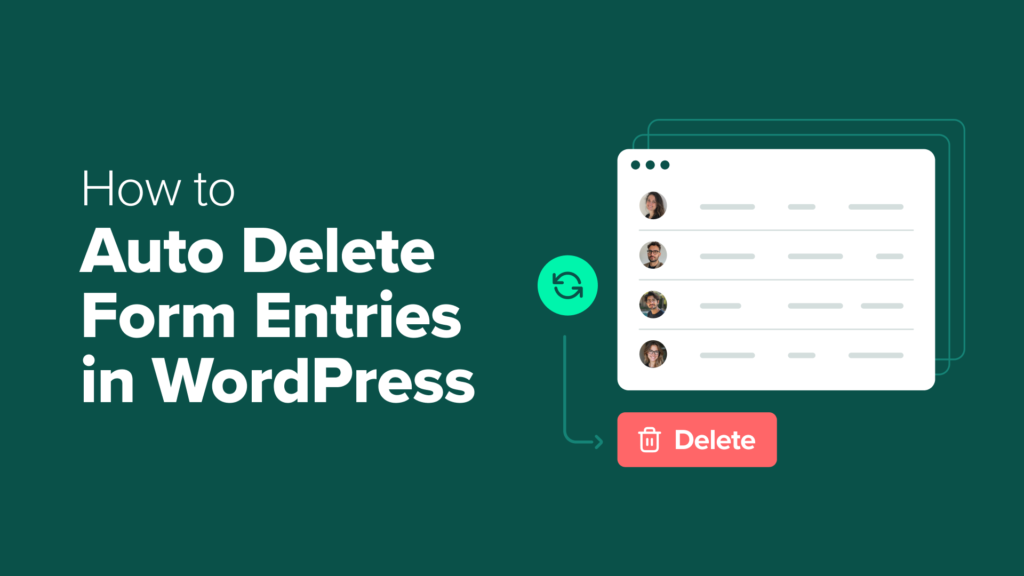Have you ever checked your outdated WordPress type submissions recently? 🤔
Types are the most effective methods to attach with guests. You may use them for questions, orders, surveys, and even donations. However as soon as these entries are answered or processed, what occurs to them?
For those who’re not managing your submissions, all that non-public knowledge simply piles up in your database. That may create two issues without delay.
First, many privateness guidelines just like the GDPR say you may solely hold private particulars for so long as they’re wanted, so holding on to them indefinitely might put your web site in danger. Second, a database that’s full of outdated entries can finally decelerate your web site.
The excellent news is that WPForms has a function that routinely deletes outdated entries for you. I’ve used this alone websites, and it’s saved me hours of cleanup whereas holding issues quick and compliant.
On this information, I’ll present you precisely the way to set it up.
Why Ought to You Auto Delete Type Entries in WordPress?
Auto-deleting outdated type entries in WordPress retains your web site quick and safe whereas lowering the chance of storing pointless private knowledge. It’s additionally a straightforward method to keep compliant with privateness legal guidelines.
Privateness laws just like the GDPR and CCPA require that you just solely hold private knowledge for so long as it’s wanted. Which means as soon as a customer’s query has been answered or an order is fulfilled, you shouldn’t maintain on to these particulars indefinitely.
Listed here are the opposite fundamental advantages of auto-deleting entries:
Decrease safety dangers: Deleting outdated entries limits the private data accessible in case your database is ever hacked.
Enhance efficiency: Hold your WordPress database lean and your web site quick.
Smaller backups: Save space for storing and make backups faster to run.
Correct reporting: Stop outdated or spammy entries from skewing your analytics.
I’ve seen this firsthand on small enterprise websites I’ve helped arrange. For instance, freelancers or coaches usually get each day inquiries by way of a contact type. As soon as these messages are answered, there’s no motive to retailer them indefinitely.

By myself websites, I’ve additionally seen how shortly outdated type knowledge piles up. As entries pile up, they add pointless bulk to your database and backups, which might make them slower to run.
👉 Briefly: auto-deleting outdated type submissions protects consumer knowledge, accelerates your web site, and helps you focus solely on the entries that matter.
Within the subsequent part, I’ll present you the way to arrange auto deletion step-by-step. You need to use the short hyperlinks under to leap straight to totally different components of the tutorial:
The best way to Auto Delete Type Entries in WordPress
The best method to delete type entries routinely is by utilizing WPForms, one of the best drag-and-drop type builder plugin for WordPress.
To deal with type entry cleanup, WPForms presents an Entry Automation addon, which helps you to arrange automated duties like deleting or exporting entries for particular varieties.
You possibly can select precisely when the duty ought to run — each day, weekly, month-to-month, or on a customized schedule. You possibly can even set guidelines to solely delete entries with particular knowledge or a sure standing.

At WPBeginner, we use WPForms for every little thing from easy contact varieties to superior surveys, and we’ve examined the Entry Automation addon completely. It really works reliably behind the scenes and helps you retain your websites GDPR-compliant.
If you wish to be taught extra concerning the plugin, try our full WPForms assessment, the place we consider all its options.
Now, let’s stroll by way of the way to arrange type entry deletion, step-by-step.
✅ Step 1: Set up and Activate WPForms
To get began, you’ll want to put in and activate the WPForms plugin in your WordPress web site.
For those who haven’t executed this earlier than, don’t fear — it’s straightforward! We have now a step-by-step information on the way to set up a WordPress plugin that walks you thru the method.
🚨 Be aware: WPForms has a free model. Nevertheless, the Entry Automation addon is simply accessible with the Elite plan.
This model additionally contains different highly effective options for enterprise house owners, like superior cost integrations, surveys and polls, and premium help. That makes it an ideal selection for rising companies.
After you activate the plugin, go to the WPForms » Settings web page out of your WordPress dashboard so as to add your license key. Be sure you are within the ‘Basic’ tab.
☝Be aware: You’ll find your license key quantity in your WPForms account profile within the Downloads tab.

When you enter your license quantity, click on the ‘Confirm Key’ button.
Now, all of the premium options accessible in your plan, together with entry to addons like Entry Automation, will likely be unlocked.
Subsequent, go to the WPForms » Addons web page in your WordPress admin sidebar and search for the ‘Entry Automation’ addon.

Whenever you discover it, merely click on the ‘Set up Addon’ button to activate it in your web site.
✏️ Step 2: Select or Create the Type You Need to Auto Delete Entries From
Now that WPForms is about up, the following step is to decide on or create the shape you need to auto delete entries from.
For those who’re working with an current type, simply go to the WPForms » All Types web page in your WordPress dashboard.
Discover the shape you need to use and click on the ‘Edit’ hyperlink underneath its identify.

This can open the shape within the visible builder.
For those who don’t have a type but, then you may create a brand new one by going to the WPForms » Add New web page.
Begin by giving your type a reputation, like ‘Contact Type’ or ‘Help Request.’ I like to recommend selecting a title that clearly defines the aim of the shape.

Then select a template that matches your wants. WPForms presents many beginner-friendly templates, like a easy contact type, a quote request type, a suggestions type, and extra.
For those who’re undecided which template to make use of or need assist getting began, then you may click on ‘Generate with AI’ to attempt the AI Type Builder.

Within the subject that claims ‘What would you prefer to create?’ simply describe the kind of type you need.
For instance, you would write “a fundamental contact type with identify, e mail, and message,” and it’ll generate the format for you.
Upon getting opened your new or pre-existing type within the drag-and-drop builder, you may add fields like identify, e mail, telephone, message, dropdowns, checkboxes, and extra.

You possibly can simply transfer them round to customise the format nonetheless you need — no coding wanted.
If it’s your first time making a type, you may discover these tutorials useful:
When you’re glad along with your type, you’re prepared for the following step.
💡 Step 3: Again Up Your Information by Exporting Entries First (Optionally available however Really useful)
Earlier than organising the automated deletion, I strongly advocate that you just again up your type knowledge first.
Whereas auto-deleting entries helps hold your web site clear and compliant, the insights you get from that knowledge may be very priceless for your small business.
That is the place you may create a sensible workflow: first, routinely save the information you want for enterprise evaluation in a safe, off-site location.
Then, have the outdated private knowledge eliminated out of your WordPress web site. That is the easiest way to steadiness knowledge evaluation with GDPR compliance.
For instance, I do know enterprise house owners who ship new lead varieties straight to their CRM to allow them to monitor gross sales with out worrying about outdated entries piling up.
Nonprofits I’ve labored with have downloaded donor surveys right into a CSV file on the finish of a marketing campaign to allow them to assessment the outcomes, then clear the unique entries to guard privateness.

The excellent news is that the identical Entry Automation addon makes exporting or downloading entries simply as straightforward as deleting them.
For a step-by-step walkthrough, see our tutorial on the way to auto-export type entries in WordPress.
🔁 Step 4: Create a Deletion Job for the Type
When you’ve arrange your exporting workflow, you’re able to arrange the deletion automation.
To do that, go to the Settings » Entry Automation tab within the left-hand menu of the WPForms builder. Right here, you may create duties that routinely export or delete type entries based mostly in your schedule and guidelines.
When you’re within the ‘Entry Automation’ tab, merely click on the ‘Add New Job’ button.

A pop-up will seem asking you to call your activity. I like to recommend selecting one thing easy and clear, like ‘Auto Delete Contact Entries‘ or ‘Cleanup Job for Survey.’
Naming your duties helps you shortly acknowledge them later should you ever need to make edits or examine your automation settings.
This activity will work like a mini workflow that runs behind the scenes.
☝ Needless to say if you wish to auto-delete entries for different varieties, you’ll have to repeat this course of for each.
Nevertheless, you may create a number of automation duties for a similar type — for instance, one to export entries to Google Drive, and one other (like this one) to routinely delete outdated knowledge.
After you add a title, simply click on the ‘OK’ button.

On the following display, select ‘Delete Entries’ as the duty kind.
Doing it will open some new settings in your display.

🧹 Step 5: Set Up Filters to Management What Will get Deleted
After selecting to delete entries, you’ll see the Filters part. This half provides you exact management, so that you solely take away what you don’t want.
First, you may filter entries based mostly on what customers kind into your type fields. That is good for routinely cleansing out low-priority submissions.
As an illustration, a preferred weblog may obtain dozens of visitor submit submissions and reader questions, and plenty of of those are off-topic pitches or spam.
On this case, organising a filter to delete entries the place the ‘Inquiry Sort’ subject is marked as ‘Visitor Publish Pitch’ or ‘Spam’ helps hold the inbox centered on real reader questions and high-quality submissions.

Subsequent, you may filter entries by their standing. That is actually helpful for eliminating junk submissions and incomplete entries.
The accessible statuses are:
Revealed – Totally submitted entries.
Partial – Entries the place somebody began the shape however didn’t end.
Deserted – Incomplete entries that timed out.
Spam – Entries flagged as spam by instruments like CAPTCHA.
Trash – Entries you’ve already moved to the trash.
I at all times advocate choosing ‘Partial’ and ‘Spam’ right here. It’s a straightforward method to routinely filter out muddle out of your database.

You possibly can even mix these filters for extra highly effective automation.
As an illustration, you would arrange a rule to delete solely ‘Revealed’ entries which can be associated to a previous occasion or a closed job software.
🗓️ Step 6: Schedule Computerized Deletion of WordPress Type Entries
As soon as your deletion settings and filters are all arrange, the ultimate step is to schedule when WPForms ought to run the automated cleanup.
To do that, scroll all the way down to the ‘Schedule’ part.
Right here, you may simply determine how usually you need the deletion activity to run — each day, weekly, or month-to-month — relying on how usually you need to filter out outdated or undesirable entries.
Subsequent, select the particular day(s) for the duty to run. For instance, you may need to delete entries each Friday, or on the first of every month.
You possibly can even add a begin date and an optionally available finish date if it is a short-term cleanup.

By default, the duty will run at midnight (based mostly in your web site server’s time), however you may customise the time to suit your workflow, like after workplace hours or earlier than your workforce begins their day.
When you save the schedule, WPForms handles every little thing within the background — routinely deleting entries based mostly in your settings with none guide effort.
🚨 Essential: Simply as a last reminder, this deletion is everlasting. As soon as an entry is gone, it can’t be recovered from WordPress, which is why I like to recommend exporting it first if the information is vital.
Lastly, click on the ‘Save’ button on the prime to retailer your settings.
For those who’re modifying an current type, then the deletion schedule will begin working routinely — no further steps wanted.
Nevertheless, should you’ve simply created a brand new type with this auto delete function, be certain to embed it on a web page or submit so it may well begin gathering entries.

📌 Need assistance with that? Try our step-by-step information on the way to embed a type in WordPress.
🔐 Bonus: Go Past Auto Deletion — Make Your Types GDPR Compliant
When you’ve arrange computerized type entry deletion to scale back knowledge and keep GDPR-friendly, you may take issues additional by enabling extra privateness options in WPForms.
It’s the most effective GDPR-friendly plugins accessible and presents a number of built-in instruments that will help you restrict private knowledge assortment, request consumer consent, and help compliance throughout your web site.
Right here’s how one can enhance compliance with only a few clicks:
✅ Add a GDPR Settlement Area: Use this to get clear consent from customers earlier than gathering their knowledge. It’s required and unselected by default to satisfy GDPR requirements.
🔒 Flip Off Person Monitoring: Disable the gathering of IP addresses, consumer agent information, and cookies to scale back knowledge assortment from the beginning.
🧾 Enable Information Entry and Deletion Requests: Construct varieties that allow customers request to view or delete their private information, as required by regulation.
⚙️ Regulate Settings Per Type: Select which varieties acquire delicate knowledge and apply stricter guidelines solely the place wanted.
These options work collectively to make your complete knowledge assortment course of extra clear, safe, and compliant.
For a whole walkthrough, try our tutorial on the way to create GDPR-compliant varieties in WordPress.
Often Requested Questions About Deleting Type Entries in WordPress
Now, let’s reply among the most typical questions our readers have about routinely deleting type entries in WordPress.
How does auto deleting entries assist with GDPR?
GDPR requires you to retailer private knowledge solely so long as needed. By auto deleting entries after a sure interval, you decrease knowledge retention dangers and keep compliant. It additionally reveals customers that you just care about their privateness.
What’s the greatest schedule for deleting type entries?
That will depend on your web site’s wants. For busy websites, each day or weekly deletion retains issues clear. For lower-traffic websites, month-to-month could be sufficient.
WPForms provides you the pliability to decide on a schedule that works for you. Plus, you may change it anytime you want. Simply set it, and WPForms will deal with it routinely within the background.
Can I delete type entries from all varieties without delay?
The auto-delete function in WPForms is designed to work on a per-form foundation. This implies you’ll need to allow it individually for every type the place you need to use it, and you’ll arrange totally different guidelines. For instance, you may need to delete contact type entries shortly however hold survey responses for an extended interval.
What occurs when an entry is auto deleted?
When WPForms auto-deletes an entry, it’s completely eliminated out of your WordPress database. It received’t be despatched to the Trash or saved in a backup inside WPForms. That’s why it’s a good suggestion to export vital entries earlier than the deletion runs, simply in case you want them later.
Can I cease WPForms from storing entries in any respect?
Sure, you may! WPForms has a function that allows you to disable entry storage utterly. That is helpful should you simply need to obtain type submissions by e mail and don’t need to hold them within the database. It’s an ideal choice for GDPR compliance and knowledge minimization.
📚 Extra Tricks to Keep GDPR-Compliant in WordPress
Need to transcend auto deleting entries? We’ve put collectively some useful guides to make your WordPress web site much more privacy-friendly.
Whether or not you’re new to GDPR or simply need to tighten issues up, these assets will stroll you thru every step:
For those who appreciated this text, then please subscribe to our YouTube Channel for WordPress video tutorials. You may as well discover us on Twitter and Fb.




